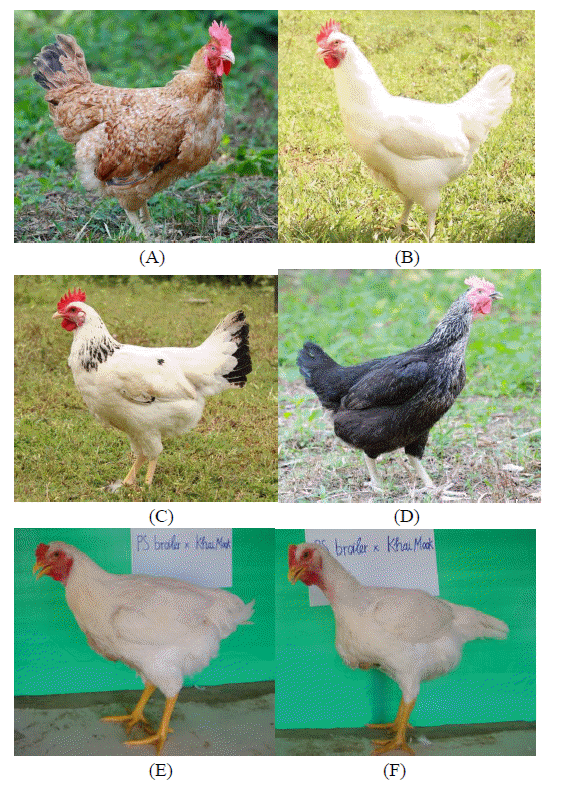Amills M, Jimenez N, Villalba D, Tor M, Molina E, Cubilo D, Marcos C, Francesch A, Sanchez A, Estany J. 2003. Identification of three single nucleotide polymorphisms in the chicken insulin-like growth factor 1 and 2 genes and their associations with growth and feeding traits. Poult Sci 82:1485–1493.


Apa R, Lanzone A, Miceli F, Mastrandrea M, Caruso A, Mancuso S, Canipari R. 1994. Growth hormone induces
in vitro maturation of follicle-and cumulus-enclosed rat oocytes. Mol Cell Endocrinol 106:207–212.


Ballard FJ, Johnson RJ, Owens PC, Francis GL, Upton FM, McMurtry JP, Wallace JC. 1990. Chicken insulin-like growth factor-I: Amino acid sequence, radioimmunoassay, and plasma levels between strains and during growth. Gen Comp Endocrinol 79:459–468.


Beccavin C, Chevalier B, Cogburn L, Simon J, Duclos M. 2001. Insulin-like growth factors and body growth in chickens divergently selected for high or low growth rate. J Endocrinol 168:297–306.


Boschiero C, Jorge EC, Ninov K, Nones K, do Rosário MF, Coutinho LL, Ledur MC, Burt DW, Moura ASA. 2013. Association of IGF1 and KDM5A polymorphisms with performance, fatness and carcass traits in chickens. J Appl Genet 54:103–112.


Byatt JC, Staten NR, Salsgiver WJ, Kostelc JG, Collier RJ. 1993. Stimulation of food intake and weight gain in mature female rats by bovine prolactin and bovine growth hormone. Am J Physiol 264:E986–E992.


Denley A, Cosgrove LJ, Booker GW, Wallace JC, Forbes BE. 2005. Molecular interactions of the IGF system. Cytokine Growth Factor Rev 16:421–439.


Falconer DS, Mackay TFC. 2001. Introducción a la genética cuantitativa. Editorial Acribia; Zaragoza, Spain:
Feng XP, Kuhnlein U, Aggrey SE, Gavora JS, Zadworny D. 1997. Trait association of genetic markers in the growth hormone and the growth hormone receptor gene in a White Leghorn strain. Poult Sci 76:1770–1775.


Goodwin W, Linacre A, Hadi S. 2007. An introduction to forensic genetics. John Wiley & Sons; Chichester, England:
Hrabia A, Paczoska-Eliasiewicz HE, Berghman LR, Harvey S, Rząsa J. 2008. Expression and localization of growth hormone and its receptors in the chicken ovary during sexual maturation. Cell Tissue Res 332:317–328.


Jaturasitha S, Srikanchai T, Kreuzer M, Wicke M. 2008. Differences in carcass and meat characteristics between chicken indigenous to northern Thailand (Black-boned and Thai native) and imported extensive breeds (Bresse and Rhode Island Red). Poult Sci 87:160–169.


Kansaku N, Hiyama G, Sasanami T, Zadworny D. 2008. Prolactin and growth hormone in birds: Protein structure, gene structure and genetic variation. J Poult Sci 45:1–6.

Kita K, Okumura J. 2001. Chicken insulin-like growth factor-I stimulates protein synthesis of chicken embryo myoblasts cultured in serum-free medium. Asian Australas J Anim Sci 14:17–20.

Mehdi A, Reza FA. 2012. Single nucleotide Polymorphisms in intron 1 of growth hormone gene and it’s association with economic important traits in Iranian Fars native fowl. Ann Biol Res 3:4028–4032.
Mu’in M, Lumatauw S. 2013. Identification of MspI polymorphism in the forth intron of chicken growth hormone gene and their associations with growth traits in Indonesia native chickens. Anim Prod 15:1–7.
Nie Q, Sun B, Zhang D, Luo C, Ishag NA, Lei M, Yang G, Zhang X. 2005. High diversity of the chicken growth hormone gene and effects on growth and carcass traits. J Hered 96:698–703.


Piper MM, Porter TE. 1997. Responsiveness of chicken embryonic somatotropes to somatostatin (SRIF) and IGF-I. J Endocrinol 154:303–310.


Promwatee N, Laopaiboon B, Vongpralub T, Phasuk Y, Kunhareang S, Boonkum W, Duangjinda M. 2013. Insulin-like growth factor I gene polymorphism associated with growth and carcass traits in Thai synthetic chickens. Genet Mol Res 12:4332–4341.


Rousseau K, Dufour S. 2007. Comparative aspects of GH and metabolic regulation in lower vertebrates. Neuroendocrinology 86:165–174.


Scanes CG. 2009. Perspectives on the endocrinology of poultry growth and metabolism. Gen Comp Endocrinol 163:24–32.


Spencer GS, Buyse J, Decuypere E, Rahimi G. 1997. Physiological inhibition of growth hormone secretion by both insulin-like growth factors-I and-II in chickens. Br Poult Sci 38:429–431.


Vasilatos-Younken R, Zhou Y, Wang X, McMurtry JP, Rosebrough RW, Decuypere E, Buys N, Darras VM, Van Der Geyten S, Tomas F. 2000. Altered chicken thyroid hormone metabolism with chronic GH enhancement
in vivo: consequences for skeletal muscle growth. J Endocrinol 166:609–620.


Wattanachant S, Benjakul S, Ledward DA. 2004. Composition, color, and texture of Thai indigenous and broiler chicken muscles. Poult Sci 83:123–128.


Yan B, Deng X, Fei Q, Hu X, Wu C, Li N. 2003. Association between single nucleotide polymorphisms of the chicken growth hormone gene and chicken growth and carcass traits. Sci Bull Sin 48:1304–1307.

Zhang C, Zhang W, Luo H, Yue W, Gao M, Jia Z. 2008. A new single nucleotide polymorphism in the IGF-I gene and its association with growth traits in the Nanjiang Huang goat. Asian Australas J Anim Sci 21:1073–1079.

Zhou H, Mitchell AD, McMurtry JP, Ashwell CM, Lamont SJ. 2005. Insulin-like growth factor-I gene polymorphism associations with growth, body composition, skeleton integrity, and metabolic traits in chickens. Poult Sci 84:212–219.










 PDF Links
PDF Links PubReader
PubReader ePub Link
ePub Link Full text via DOI
Full text via DOI Full text via PMC
Full text via PMC Download Citation
Download Citation Print
Print





